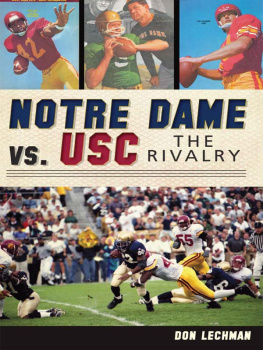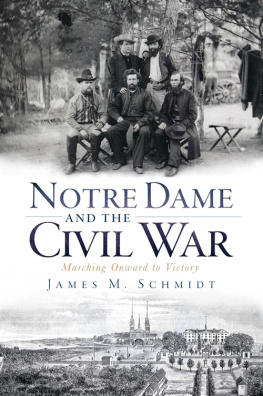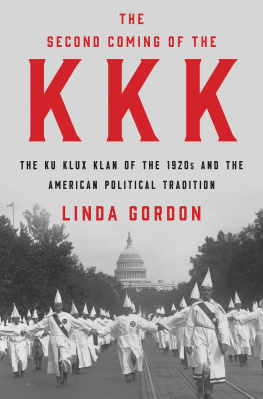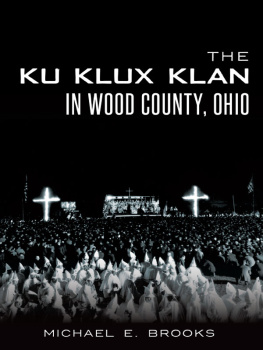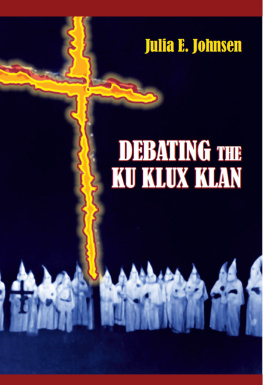NOTRE DAME VS. THE KLAN
University of Notre Dame Press
Notre Dame, Indiana 46556
www.undpress.nd.edu
Copyright 2018 by Todd Tucker
All Rights Reserved
Published in the United States of America
Library of Congress Cataloging-in-Publication Data
Names: Tucker, Todd, 1968 author.
Title: Notre Dame vs. the Klan : how the Fighting Irish defied the KKK / Todd Tucker.
Other titles: Notre Dame versus the Klan
Description: Paperback edition. | Notre Dame, Indiana : University of Notre Dame Press, [2018] | Includes bibliographical references and index. | Identifiers: LCCN 2018024532 (print) | LCCN 2018025153 (ebook) | ISBN 9780268104351 (pdf) | ISBN 9780268104368 (epub) | ISBN 9780268104344 (paper : alk. paper) | ISBN 0268104344 (paper) : alk. paper)
Subjects: LCSH: University of Notre DameHistory20th century. | Ku Klux Klan (1915- )IndianaHistory. |
Anti-CatholicismIndianaHistory20th century.
Classification: LCC LD4113 (ebook) | LCC LD4113 .T83 2018 (print) | DDC 378.772/89dc23
LC record available at https://lccn.loc.gov/2018024532
This paper meets the requirements of ANSI/NISO Z39.48-1992
(Permanence of Paper).
This e-Book was converted from the original source file by a third-party vendor. Readers who notice any formatting, textual, or readability issues are encouraged to contact the publisher at
PREFACE TO THE 2018 EDITION
IT WAS A BLUSTERY DAY IN SOUTH BEND, SHORTLY AFTER St. Patricks Day 2005, the kind of day when the northern Indiana winter is refusing to yield to spring, a mixture of cold rain and wet snow in the air. The days were still short, and it was dark at the Northern Indiana Center for History (known today as the History Museum), where I was scheduled to speak after regular museum hours. I had arrived early, found my way through the darkened exhibits on Studebaker and Rockne, and walked into the meeting room where my hosts had anxiously gathered. The Klan, they told me, was on its way.
Id been waiting for them. The book, the one youre reading now, had made a splash since publication the previous summer, capturing the publics endless fascination with Notre Dame and their darker but just as durable fascination with the Klan. Id appeared in dozens of articles and on radio shows, culminating with a C-SPAN broadcast of a talk that I gave in Indianapolis in September. People had asked me along the way if the Klan ever showed up and made trouble at any of my events, but the answer had thus far been no. I started telling people, when they asked if Id encountered the Klan, that they didnt appear to be big book people.
But now they were on their way. Theyd called in advance, let it be known. I knew that the Klan, in all its incarnations, had always displayed a kind of atavistic media savvy, a flare for public events, drama, and spectacles. The occasion of the 1924 Notre Dame riot in my book, after all, was a parade, and D. C. Stephenson, the Indiana Klans mad genius, had always leveraged parades and rallies to recruit new members and garner publicity. And now it looked like it was my turn. The nervous volunteers who ran the center considered canceling the event. By then guests were arriving, however, so they decided, reluctantly, to press on. The South Bend police were called, and they parked a cruiser conspicuously in front of the main entrance.
I was standing at the podium when they arrived, a group of six, filing into the auditorium with their eyes straight ahead, taking up the front row. They were not in robes and hoods, but most wore military fatigues instead, some with T-shirts and hats that said BORDER PATROL. They had soldierly haircuts and serious expressions that reminded me of Timothy McVeigh, the Oklahoma City bomber. Their leader was of a more scraggly variety, disheveled, older than the rest, but followed deferentially as he selected their seats. I watched as word spread throughout the audience. People pointed, whispered worriedly, and craned their necks to get a better look.
THE FIRST LINE OF MY PROPOSAL FOR THIS BOOK, WRITTEN when publication was just a dream, stated, On May 17, 1924, two uniquely American institutions collided in Northern Indiana. I argued to prospective publishers that the 1924 riot also featured two of the most enduring institutions in our nation, two institutions that would be symbolic adversaries again and again. As the border patrol shirts of my Klansmen listeners indicated, the Klan presented itself as the defender of a pure America, unsullied by immigrant blood, which was also a large plank of its platform when members marched in South Bend in 1924. From 1924 to 2005 the nationalities of the immigrants would change, but the Klan arguments against them stayed relatively static over the yearsas did the Catholicism of the newcomers. The argument remained powerfully resonant with a particular segment of the American population.
With regularity, people would call me in the years after publication to speak about the Klan and its surprising resurgence, which proved to me not surprising at all. The most common comment I got from Hoosiers when hearing the story was, I cant believe Ive never heard about this. Indeed, there was also a strong strand of denial in many of the stories that called for my attention in the years after the books publication. In murals at Indiana University a Klan rally is among the many scenes depicting Indiana history, complete with a burning cross and white robes. Student groups regularly call for these muralsmasterpieces painted by Thomas Hart Benton for the 1933 Century of Progress Exposition in Chicagoto be removed, confusing an accurate (and moving, and artistically significant) depiction of racist history with racism itself. Another example, set on yet another college campus, provided my book the biggest dose of publicity it would receive.
It began in November 2007, a full three years after publication, at Indiana UniversityPurdue University Indianapolis (IUPUI). Keith Sampson, a student and an employee of the school (he was a janitor) was reading my book on breaks when one of his coworkers took offense. The schools affirmative action office promptly censured Sampson, telling him in a letter, You used extremely poor judgement by insisting on openly reading a book related to a historically and racially abhorrent subject in the presence of Black coworkers. The letter went on, We conclude that your conduct constitutes racial harassment in that you demonstrated disdain and insensitivity to your co-workers who repeatedly requested that you refrain from reading the book which has such an inflammatory an offensive topic in their presence. He was instructed to stop reading the book in the immediate presence of your co-workers and when reading the book to sit apart from the immediate proximity of these co-workers. Please be advised, any future substantiated conduct of a similar nature could result in serious disciplinary action.



